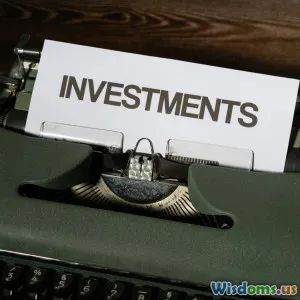
Telltale Signs Your Angel Investor Might Walk Away
8 min read Discover key indicators that your angel investor might exit and how to proactively safeguard your startup’s future. (0 Reviews)
Telltale Signs Your Angel Investor Might Walk Away
Introduction
Angel investors often play a pivotal role in launching and growing startups by providing not just capital but mentorship, credibility, and vital networks. However, angel investors are not always long-term partners; they may walk away due to various reasons—some planned, others unexpected. This could be devastating if unanticipated, leaving startups scrambling for funding, stability, and strategic direction.
Understanding the subtle and overt signs of investor disengagement can empower founders to take corrective steps early—saving crucial time and resources. In this article, we'll delve into telltale signs that suggest your angel investor might be preparing to exit. We’ll supplement these insights with real examples and actionable advice to help you stay ahead of the curve.
1. Decreased Communication and Engagement
One of the first visible red flags is a marked reduction in communication frequency and quality from your investor. Startups often enjoy active involvement from angels during early stages, including regular updates, meetings, and strategy discussions.
Example:
Sarah, CEO of a fintech startup, noticed her lead investor suddenly stopped responding to weekly progress emails and missed scheduled calls over three consecutive months. This disengagement preceded a funding delay.
What to Watch For:
- Delayed email responses or ignored messages
- Canceled or postponed meetings with minimal explanations
- Lack of input in decisions or avoidance of leadership conversations
Why This Matters:
Active communication often reflects ongoing commitment. Silence or withdrawal can signal doubts about the company’s direction or financial metrics.
2. Missed or Delayed Fund Transfers
Angel investments frequently come in rounds, with agreed-upon tranches tied to milestones. A failure to deliver committed funds on time is a serious warning sign.
Data Insight:
CB Insights reports that 29% of startups fail due to running out of cash or inability to raise further funding. Delays or withdrawals from early investors often precipitate this crisis.
Indicators:
- Unexplained postponements of funding disbursement
- Requests for additional due diligence or updated business plans, beyond usual process
- Investor sudden interest in renegotiation of terms
Real-World Example:
In 2019, a healthtech startup faced significant setbacks after their primary angel delayed a $200k installment for two months leading their team to seek bridge financing under less favorable conditions.
3. Shifting Investor Priorities or Focus
An angel investor’s interests and risk tolerance may evolve. This shift can reduce their enthusiasm or willingness to back your venture further.
Scenario:
A seasoned investor initially passionate about eco-friendly startups might pivot focus to blockchain technology, signaling dwindling support for your renewable energy startup.
How to Detect this:
- Sudden change in topics during discussions, consistently steering away from your sector
- Emerging investments in competing startups or markets
- Reduction in offers of help, connections, or advice related to your specific niche
Expert Insight:
Jordan Fein, a VC consultant, advises that founders maintain a ‘pulse check’ on investor portfolios to anticipate changes in priorities.
4. Negative or Growing Concerns about Business Metrics
When key performance indicators don’t meet investor expectations, confidence erodes. Angels pay close attention to customer acquisition costs, user growth, revenue projections, and burn rate.
Example:
If a SaaS startup delays achieving a projected monthly recurring revenue (MRR) target, an investor might question continued investment viability.
Key Metrics That Matter:
- Revenue growth (or contraction)
- Customer growth and retention
- Operational efficiency and burn rate
How to Respond:
Transparent communication explaining challenges and pivot plans can sometimes stabilize investor confidence. Pretending problems don’t exist often hastens the exit.
5. Reduced Strategic Support and Mentorship
Angel investors typically add value beyond money, helping with strategic insights, introductions, and board participation. A decline in this support is a subtle but troubling sign.
Signs:
- Investor declines invitations to strategy sessions
- Limited feedback on pitches to other investors or customers
- No longer promoting the startup within their network
Why It Matters:
Loss of mentorship can stunt startup growth and morale, signaling investor disengagement or intent to withdraw.
6. Investor Behavior Changes Under External Stressors
External factors—market downturns, regulatory changes, personal investor issues—can impact their commitment.
Cases:
- During economic recessions, many angels become risk-averse, prioritizing existing investments rather than new rounds.
- Personal financial troubles (divorce, health) may force withdrawal irrespective of startup success.
What Founders Can Do:
Keep open channels for dialogue, show empathy, and collaboratively explore alternatives like deferred funding or co-investor involvement.
7. Proactive Signs: Investor Actively Seeking Exit
The most obvious but often overlooked sign is when an investor explicitly signals or negotiates exit terms.
Examples:
- Discussion about secondary sales or buybacks
- Investor selling equity stakes to others
- Mention of limits on follow-on funding
Strategic Importance:
Early awareness allows founders to proactively plan for new investment rounds or pivot business models without sudden disruption.
Conclusion
The relationship between founders and angel investors is nuanced and dynamic. While angels fuel growth, they are also inherently taking risks and may reconsider their involvement over time. Spotting the signs that your angel investor might walk away—ranging from communication lapses to missed funding or strategic disengagement—can save your startup from sudden shocks.
Proactive strategies include maintaining transparent communication, promptly addressing underperformance metrics, diversifying funding sources, and nurturing other investor relationships. Remember, a savvy founder anticipates potential investor exits and plans contingencies, turning potential crises into strategic opportunities.
By staying vigilant and responsive, you can strengthen investor partnerships and secure your startup’s growth trajectory.
References
- CB Insights. "The Top 20 Reasons Startups Fail." 2021.
- Jordan Fein, VC Consultant, "Maintaining Investor Relations." 2023.
- Real founder testimonials from TechCrunch and Entrepreneur interviews.
This article is designed to empower entrepreneurs and startup founders by illuminating key investor behaviors and providing practical advice to safeguard funding and growth.
Rate the Post
User Reviews
Other posts in Private Equity & Venture Capital
Popular Posts

















